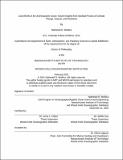| dc.contributor.advisor | Anne L. Cohen and Weifu Guo. | en_US |
| dc.contributor.author | Mollica, Nathaniel R.(Nathaniel Rust) | en_US |
| dc.contributor.other | Joint Program in Oceanography/Applied Ocean Science and Engineering. | en_US |
| dc.contributor.other | Massachusetts Institute of Technology. Department of Earth, Atmospheric, and Planetary Sciences. | en_US |
| dc.contributor.other | Woods Hole Oceanographic Institution. | en_US |
| dc.date.accessioned | 2021-05-24T20:22:51Z | |
| dc.date.available | 2021-05-24T20:22:51Z | |
| dc.date.copyright | 2021 | en_US |
| dc.date.issued | 2021 | en_US |
| dc.identifier.uri | https://hdl.handle.net/1721.1/130752 | |
| dc.description | Thesis: Ph. D., Joint Program in Oceanography/Applied Ocean Science and Engineering (Massachusetts Institute of Technology, Department of Earth, Atmospheric, and Planetary Sciences; and the Woods Hole Oceanographic Institution), February, 2021 | en_US |
| dc.description | Cataloged from the official PDF of thesis. | en_US |
| dc.description | Includes bibliographical references. | en_US |
| dc.description.abstract | Anthropogenic emissions of greenhouse gases are driving rapid changes in ocean conditions. Shallow-water coral reefs are experiencing the brunt of these changes, including intensifying marine heatwaves (MHWs) and rapid ocean acidification (OA). Consequently, coral reefs are in broad-scale decline, threatening the livelihoods of hundreds of millions of people. Ensuring survival of coral reefs in the 21st century will thus require a new management approach that incorporates robust understanding of reef-scale climate change, the mechanisms by which these changes impact corals, and their potential for adaptation. In this thesis, I extract information from within coral skeletons to 1) Quantify the climate changes occurring on coral reefs and the effects on coral growth, 2) Identify differences in the sensitivity of coral reefs to these changes, and 3) Evaluate the adaptation potential of the keystone reef-building coral, Porites. | en_US |
| dc.description.abstract | First, I develop a mechanistic Porites growth model and reveal the physicochemical link between OA and skeletal formation. I show that the thickening (densification) of coral skeletal framework is most vulnerable to OA and that, under 21st century climate model projections, OA will reduce Porites skeletal density globally, with greatest impact in the Coral Triangle. Second, I develop an improved metric of thermal stress, and use a skeletal bleaching proxy to quantify coral responses to intensifying heatwaves in the central equatorial Pacific (CEP) since 1982. My work reveals a long history of bleaching in the CEP, and reef-specific differences in thermal tolerance linked to past heatwave exposure implying that, over time, reef communities have adapted to tolerate their unique thermal regimes. Third, I refine the Sr-U paleo-thermometer to enable monthly-resolved sea surface temperatures (SST) generation using laser ablation ICPMS. | en_US |
| dc.description.abstract | I show that laser Sr-U accurately captures CEP SST, including the frequency and amplitude of MHWs. Finally, I apply laser Sr-U to reconstruct the past 100 years of SST at Jarvis Island in the CEP, and evaluate my proxy record of bleaching severity in this context. I determine that Porites coral populations on Jarvis Island have not yet adapted to the pace of anthropogenic climate change. | en_US |
| dc.description.statementofresponsibility | by Nathaniel R. Mollica. | en_US |
| dc.format.extent | 234 pages | en_US |
| dc.language.iso | eng | en_US |
| dc.publisher | Massachusetts Institute of Technology | en_US |
| dc.rights | MIT theses may be protected by copyright. Please reuse MIT thesis content according to the MIT Libraries Permissions Policy, which is available through the URL provided. | en_US |
| dc.rights.uri | http://dspace.mit.edu/handle/1721.1/7582 | en_US |
| dc.subject | Joint Program in Oceanography/Applied Ocean Science and Engineering. | en_US |
| dc.subject | Earth, Atmospheric, and Planetary Sciences. | en_US |
| dc.subject | Woods Hole Oceanographic Institution. | en_US |
| dc.title | Coral reefs in the anthropocene ocean : novel insights from skeletal proxies of climate change, impacts, and resilience | en_US |
| dc.type | Thesis | en_US |
| dc.description.degree | Ph. D. | en_US |
| dc.contributor.department | Joint Program in Oceanography/Applied Ocean Science and Engineering | en_US |
| dc.contributor.department | Massachusetts Institute of Technology. Department of Earth, Atmospheric, and Planetary Sciences | en_US |
| dc.contributor.department | Woods Hole Oceanographic Institution | en_US |
| dc.identifier.oclc | 1251926984 | en_US |
| dc.description.collection | Ph.D. Joint Program in Oceanography/Applied Ocean Science and Engineering (Massachusetts Institute of Technology, Department of Earth, Atmospheric, and Planetary Sciences; and the Woods Hole Oceanographic Institution) | en_US |
| dspace.imported | 2021-05-24T20:22:51Z | en_US |
| mit.thesis.degree | Doctoral | en_US |
| mit.thesis.department | EAPS | en_US |
